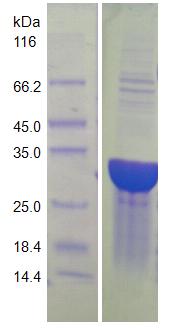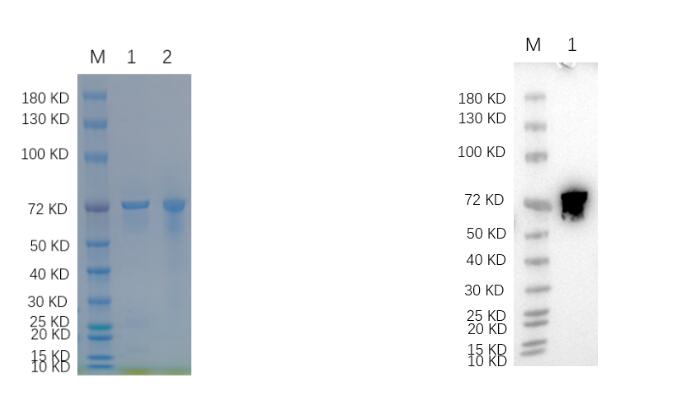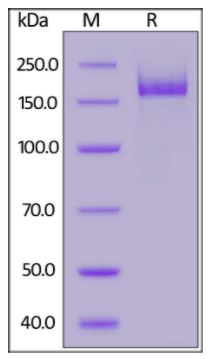Infectious Diseases Targets
🧪 HBx-3258V
Source: E.coli
Species: HBV
Tag: His
Conjugation:
Protein Length:

🧪 HBsAg-255H
Source: P.pastoris
Species: HBV
Tag: Non
Conjugation:
Protein Length:

🧪 HBsAg-268H
Source: S.Cerevisiae
Species: HBV
Tag:
Conjugation:
Protein Length:


🧪 CdtB-01C
Source: E.coli
Species: Campylobacter jejuni
Tag: His
Conjugation:
Protein Length:

🧪 HIV1 reversetranscriptase-01V
Source: E.coli
Species: HIV
Tag: His
Conjugation:
Protein Length:

🧪 PLY-25S
Source: E.coli
Species: Streptococcus pneumoniae
Tag: His&SUMO
Conjugation:
Protein Length:

🧪 HBcAg-19
Source: P.pastoris
Species: HBV
Tag: Non
Conjugation:
Protein Length: 183 a.a.

🧪 HA-412I
Source: HEK293
Species: H9N2
Tag: Avi&His
Conjugation: Biotin
Protein Length: 19-338 a.a.

🧪 SAG1-890T
Source: E.coli
Species: Toxoplasma gondii
Tag: Non
Conjugation:
Protein Length: 45-198 aa


🧪 CDA016
Source: Human Plasma
Species: HBV
Tag: Non
Conjugation:
Protein Length:


🧪 Spike-191V
Source: HEK293
Species: Sars-CoV-2
Tag: His
Conjugation:
Protein Length: Val16-Arg685


🧪 Spike-190V
Source: HEK293
Species: Sars-CoV-2
Tag: His
Conjugation:
Protein Length: Arg319-Phe541

 Full L.
Full L.
🧪 Spike-208V
Source: HEK293
Species: Sars-CoV-2
Tag: His
Conjugation:
Protein Length: Val16-Pro1213


🧪 HA-002
Source: E.coli
Species: H1N1
Tag: His
Conjugation:
Protein Length:


🧪 HA-001
Source: HEK293
Species: H1N1
Tag: His
Conjugation:
Protein Length:

SubCategories
Background
What are Infectious Diseases?
Many microorganisms live in or on our bodies. They are usually harmless or even beneficial to the human body. But under certain conditions, some microbes can cause disease. Infections occur when microbes invade the body and cause disease. Infectious diseases are disorders caused by organisms, such as bacteria, viruses, fungi or parasites. Many organisms live in and on our bodies. They're normally harmless or even helpful. But under certain conditions, some organisms may cause disease.
Some infectious diseases can be passed from person to person. Some are transmitted by insects or other animals. Many pathogens do not cause infection, some even help. Many pathogens that live on the skin or in the body are normal and do not cause harm. These are called resident flora. Other pathogens do not normally live in or on the body and can cause disease.
Infections are caused by harmful pathogens that enter the body. It can enter the body in the following ways: nose or mouth, skin, from cuts, scratches or bites, sexual contact with an infected partner. If you eat or drink something that contains pathogens, pathogens can get into your mouth. If you touch an object contaminated with pathogens and then touch the nose or mouth, they may also enter the nose or mouth. Some bacteria, usually viruses, are inhaled in respiratory droplets produced when an infected person nearby coughs, sneezes, sings, exercises, or speaks.
Signs and symptoms vary depending on the organism causing the infection, but often include fever and fatigue. Mild infections may respond to rest and home remedies, while some life-threatening infections may need hospitalization. Frequent hand washing, especially when handling food or in close contact with people, can help protect against pathogens. And many more infections can be prevented by vaccination.
Causes of Infectious Diseases
The transmission of infectious diseases usually requires three basic links: the source of infection, the route of transmission and the susceptible population.
Source of infection: refers to the person or animal that can expel pathogens, such as infectious disease patients or animals carrying pathogens.
Route of transmission: The route by which a pathogen, after its expulsion from the source of infection, reaches a new susceptible person. The route of transmission can be air, droplet, fecal mouth, contact, blood, sexual contact, vertical transmission (mother-to-child transmission), etc.
Susceptible population: refers to a group of people who lack immunity to an infectious agent and are therefore susceptible to the disease.
Infectious diseases are diseases caused by pathogens that can be transmitted between people or between humans and animals. Pathogens include microorganisms such as bacteria, viruses, fungi and parasites.

Overview of Bacterial Infections. Many bacteria live on and in the bodies of humans and animal-on the skin and in the respiratory tract, mouth and digestive tract, reproductive tract and urinary tract - without causing any harm. These bacteria are called resident or normal flora. Only a few types of bacteria can cause disease. They are called pathogenic bacteria. Sometimes, under certain conditions, resident bacteria can act as pathogens to cause disease. Bacteria can cause disease by releasing harmful substances (toxins), directly invading body tissues, or both. Certain bacteria can trigger inflammation that can affect the heart, lungs, nervous system, kidneys, or gastrointestinal tract.
Overview of Viral Infections. A virus is an infectious microbe that is much smaller than fungi and bacteria and must invade living cells in order to reproduce (replicate). The virus absorbs and enters a cell (called a host cell), where it releases its own DNA or RNA. Infected cells often die because the virus prevents them from performing their normal physiological functions. When the infected cell dies, it releases new viruses that go on to infect other cells. Viruses can be divided into DNA viruses and RNA viruses according to whether they use DNA or RNA to replicate. DNA viruses include herpes viruses. RNA viruses include SARS-CoV2.
Overview of Fungal infections. Fungi can grow in two forms, yeast with single round cells and mold with slender filamentous mycelium. Some fungi exist in both forms throughout their life cycle. These fungi are called dimorphous fungi. Fungi reproduce by spreading microspores. These spores are usually found in the air and soil, where they can be inhaled or come into contact with body surfaces (mainly the skin). For this reason, fungal infections usually start in the lungs or skin.
Overview of Parasitic Infections. Parasites are divided into protozoa, which consist of a single cell, and worms, which consist of multiple cells and have internal organs. Protozoa reproduce by cell division and can multiply in the human body. Protozoa include a wide range of single-celled organisms, such as Plasmodium, which migrates through the bloodstream and causes malaria. Instead, most worms reproduce by laying eggs or larvae that grow in the environment for some time before they have the ability to infect people. Development in the environment may also involve other animals (intermediate hosts). Worms include nematodes, such as hookworms, and flatworms, such as tapeworms and flukes.
Infectious Diseases Examples
Bacterial infections can be classified according to the various ways in which bacteria are classified. For example, infections can be classified as caused by Gram-negative or Gram-positive bacteria.
- Gram-negative infections include E. coli infection, brucellosis, pseudomonas infection, Salmonella infection, etc.
- Gram-positive infection includes pneumococcal infection, staphylococcal infection, streptococcal infection, etc.
- Some infections are classified by the form of bacteria. For example, infections caused by spirochaetes (spiral-shaped bacteria) are classified as spirochaeta infections. Including: leptospirosis, Lyme disease, syphilis, etc.;
- Other infections can be classified by whether the pathogenic bacteria require oxygen or thrive in an oxygen-free environment. Bacteria that do not need to live and grow in an aerobic environment are called anaerobic bacteria. Anaerobic bacterial infections include actinomycosis, botulism, clostridium infection, tetanus, etc.

Viral infections can be classified according to the organ systems they affect, such as the lungs, digestive tract, skin, liver, central nervous system, and mucous membranes. Upper respiratory tract infections (nose, throat, upper airway, and lung infections) are probably the most common viral infections.
- Upper respiratory infections: including sore throat, sinusitis and the common cold. Other viral respiratory infections include influenza, pneumonia and coronaviruses, including SARS-CoV-2 (the virus that causes COVID-19).
- Skin infections: Some viral infections cause only skin lesions, such as mollusc contagiosus, while others can cause systemic manifestations or lesions in other parts of the body, such as shingles.
- Liver infection: There are at least five specific viruses (hepatitis A, B, C, butyl E virus) that can cause hepatitis, each of which causes a specific type of hepatitis.
- Arboviruses: Certain viruses cause fever and a tendency to bleed, and are mainly transmitted by mosquitoes, ticks, or contact with infected animals.
- Enterovirus infection: Enteroviruses, including Coxsackie and Echoviruses, can cause multisystem syndromes, as cytomegalovirus infection.

Fungal infections can affect one part of the body (localized) or multiple parts (systemic). Localized fungal infections affect only one area of the body, they usually affect the skin and nails, vagina, or mouth, and can occur in people with normal or weakened immune systems. Systemic fungal infections can affect organs such as the lungs, eyes, liver, and brain, as well as the skin, and they usually occur in people with compromised immune systems. Fungal infections can be distinguished according to the site of infection and can be divided into:
- Dermatomycosis: An infection involving the skin and its appendages, such as hair and nails, is accompanied by an immune response from the host. Such as: athlete's foot, tinea, gray nails, etc.;
- Subcutaneous tissue mycosis: Infects the skin and subcutaneous tissues, including muscle and connective tissue, but does not usually spread to vital organs through the bloodstream;
- Systemic mycosis: Candidiasis, which can affect the mouth, throat, esophagus, genitals and other internal organs; Aspergillus disease, an infection caused by Aspergillus fungi that can affect the lungs and other organs; Cryptococcosis, an infection caused by fungi of the genus Cryptococcus, commonly found in the lungs and central nervous system;
- Other specific types of fungal infections such as sporotrichosis and chromoblastomycosis can spread along lymphatic vessels, affecting the skin and lymph nodes.

Parasitic infections can be classified according to different criteria, such as by the species of parasitic organisms, by the parasitic environment, and by the relationship between the parasite and the host.
- Classification by parasitic environment classification: can be divided into internal parasites and surface parasites. Parasitic organisms such as roundworms, hookworms, tapeworms, etc. live in the human digestive tract, lungs, liver, blood ducts, and even brain tissue and eyeballs. Extracorporeal parasites such as sarcoptes scabies and follicularis mites, which live on the surface of human skin or in human hair.
- Classification by route of infection: After being swallowed orally, the parasite remains in the intestine or penetrates through the intestinal wall to invade other organs. Usually the parasite enters the mouth through fecal-oral transmission. Some parasites can enter directly through the skin. Other parasites are spread through insect bites. In rare cases, parasitic diseases can be transmitted through blood transfusions, organ transplants, sharing needles with an infected person, or between a pregnant woman and her fetus.

Symptoms of Infectious Diseases
Infectious diseases can manifest a wide range of symptoms depending on the type of pathogen, the part of the body affected, and the individual's immune response. Here are some common symptoms associated with various infectious diseases:
- Fever: An increase in body temperature is a common response to many infections as the body attempts to fight off the invading pathogens.
- Cough: A cough can be a symptom of respiratory infections, such as the common cold, influenza, or COVID-19.
- Sore throat: This can be caused by viral or bacterial infections and is often accompanied by pain when swallowing.
- Headache: Headaches can be a symptom of many infections, including those affecting the respiratory system, such as sinus infections.
- Muscle and Joint Pain: Inflammation and the immune response can lead to aches and pains throughout the body.
- Skin Infections: Symptoms can range from minor skin rashes to more severe conditions like cellulitis, which is a bacterial infection of the skin's deeper layers.
- Meningitis Symptoms: These can include a stiff neck, severe headache, high fever, and sometimes a rash.
- Gastroenteritis Symptoms: Nausea, vomiting, diarrhea, and abdominal pain are typical in gastroenteritis, which can be caused by a variety of pathogens.
Treatment of Infectious Diseases
To fight infectious diseases, first do prevention. Hand washing is an effective way to prevent the spread of infectious microbes from one person to another. Wearing a mask can help reduce the spread of respiratory infections. Sometimes, antibiotics are given to people who are not yet infected to prevent them from becoming infected, such as healthy people who should also be given antibiotics prophylactically during surgical procedures such as abdominal surgery or organ transplants. Vaccination is one of the most effective ways to prevent infection. People at high risk of infection (especially infants, children, the elderly and people with AIDS) should be vaccinated to reduce the risk of developing the disease.

For those unfortunate enough to be infected, a series of treatment measures are needed to deal with the series of diseases caused by the infection. The treatment of infectious diseases encompasses a variety of approaches aimed at eliminating the pathogen, controlling the spread of the disease, and supporting the patient's recovery.
- Etiological Treatment
Antibiotics: Used for bacterial infections, with selection based on sensitivity testing and the specific pathogen.
Antiviral Medications: Specific treatments for viral infections, which may include drugs that interfere with viral replication.
Chemotherapy: The use of chemical agents to treat certain infections, such as antimalarial drugs for malaria.
- Supportive and Symptomatic Treatment
Hydration: Ensuring patients receive adequate fluids, which may be crucial for recovery.
Nutrition: Providing necessary nutrients, which can be administered through feeding tubes or intravenously if the patient cannot eat.
Medication for Symptoms: Using medications to alleviate symptoms such as fever, pain, or nausea.
- Immunotherapy
Vaccines: Preventing diseases through vaccination, which can also be used in some cases for treatment after exposure.
Immunoglobulins: Administering antibodies to provide passive immunity to patients with weakened immune systems.
Related Resources
As emphasized by the World Health Organization (WHO), the key strategy for the prevention and control of infectious diseases is "early detection, early diagnosis, early treatment." Data show that through effective vaccination programs, the incidence of infectious diseases such as measles and polio has been greatly reduced. However, we still need to be vigilant about the emergence of new infectious diseases, such as the 2019 novel coronavirus (COVID-19) pandemic. In the fight against infectious diseases, scientific research provides us with a powerful weapon. In addition, interdisciplinary cooperation is also key to tackling infectious diseases.
By practicing good personal hygiene, getting vaccinated, and seeking timely medical attention, we can do our part to stop the spread of infectious diseases. At the same time, we should also pay attention to the vulnerable groups, provide them with necessary support and help, and jointly build a healthier and safer social environment.

